You probably have seen people practicing Acro Yoga on the beach or at the park, right? They were moving effortlessly, flowing naturally from one move to another like in a dance.
So you became curious and you want to give it a try? You are definitely not alone since Acro Yoga has become increasingly popular in the last decade.
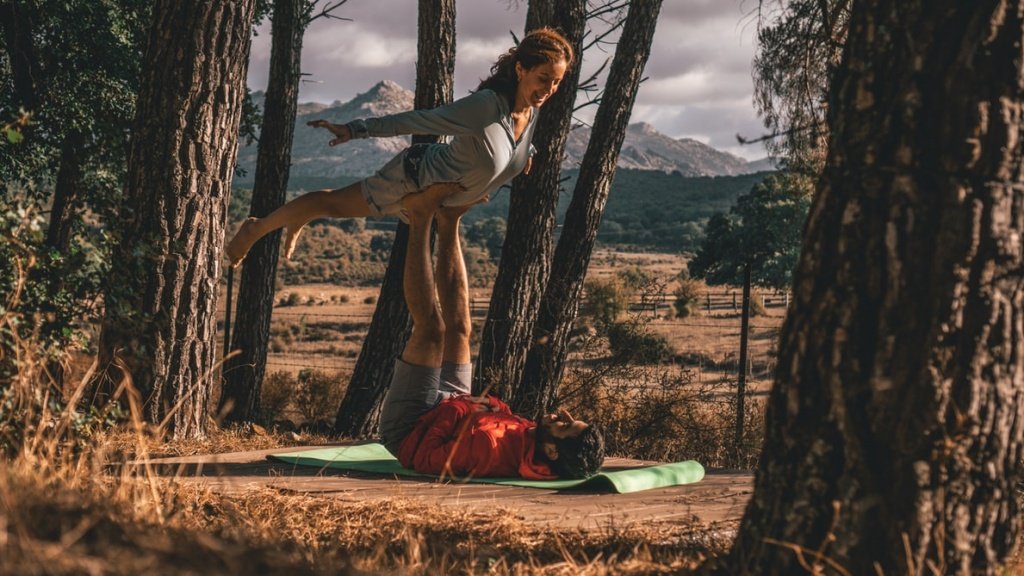
In this article we will explain what Acro Yoga is and its benefits (besides fun!), we will give you some useful tips for beginners to start learning this technique and we will show you some basic Acro Yoga positions that you can begin practicing right away.
So, let’s start from the basics!
What is Acro Yoga?
As the name suggests, Acro Yoga is a combination of Yoga & Acrobatics in which two or more individuals create spectacular figures with their bodies off the ground. It takes flexibility, balance, strength and lots of trust.
It is a great technique to help create strong bonds among the practitioners: there is physical contact, mutual support, constant communication and deep understanding of each other’s body signs.
Did we mention it’s fun?
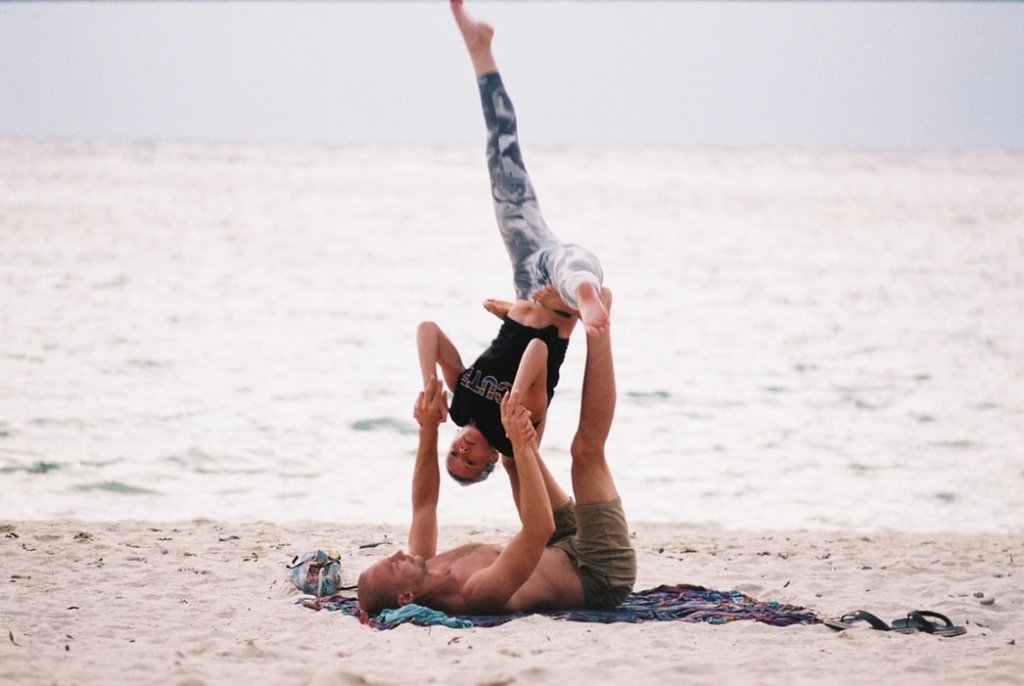
A little history of Acro Yoga
Acro Yoga is a branch of Yoga with its roots also in Acrobatics It’s hard to identify the founder. There’s a video from 1938 showing yoga teacher T. Krishnamacharya basing a child in some backbend stretches.
In more recent times, Benjamin Marantz created in 1985 the AcroSage inversion therapy involving inverted flying postures and massage techniques.
Still in the 80s, Ken Nateshvar Scott created Contact Yoga opening the solo practice to a more social dimension. Eventually, in 1999 Acroyoga Montreal (AYM) was founded by Eugene Poku and Jessie Goldberg and it fully operational in 2003.
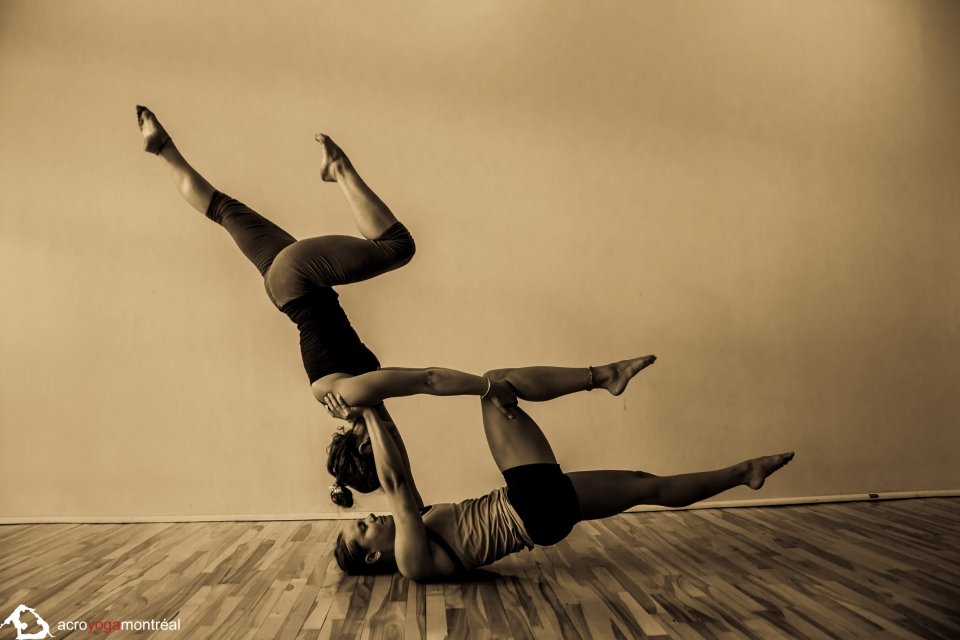
Their style of Acro Yoga blends dance, yoga, and acrobatics. Acroyoga International (AYI) was created in 2003 by Jason Nemer and Jenny Sauer-Klein to spread this practice all over the world and create a structured approach to training teachers.
Getting started: The Basics of Acro Yoga
In an Acro Yoga session, there are 2 fundamental roles (base and flyer) and a VERY recommended one (spotter), especially if you are a beginner.
The Base is firmly in contact with the ground, normally with the whole back. You might think it takes lots of muscular power to lift another person but as soon as you gain experience, you will realize the trick is to keep legs and arms “bone-stacked” (that is, perpendicular to the ground).
This way, the weight of the flyer is transferred to the floor through the bones instead of requiring lots of strength. Both feet and hands can be used by the base to support the flyer or even other parts of the body.
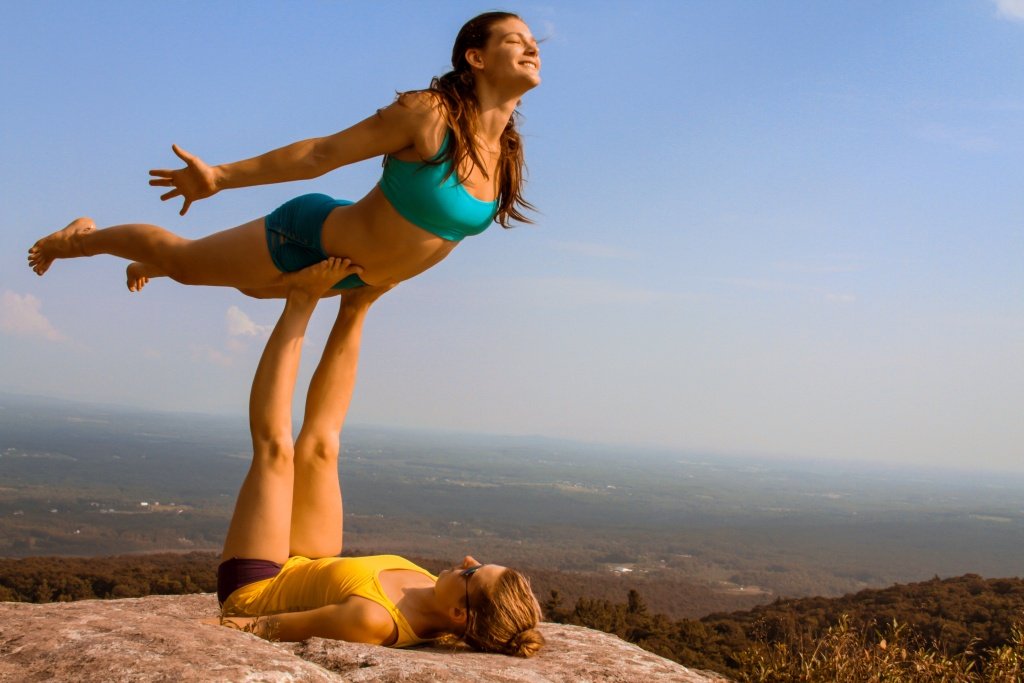
The Flyer… flies! Elevating on a firm base, the flyer soars in the air creating both static and dynamic acro yoga poses. A Flyer needs balance, trust, and a strong core.
It normally takes some time to find a good connection with their base but once it is established a flyer can confidently flow from one move to another.
The flyer constantly communicates with their base, verbally at the beginning, until both bodies naturally find each other without words.

The Spotter will take care of “safe landings”, should you lose your balance. Especially when starting with Acro Yoga or trying a new position, have a friend spot you during your physical practice.
Spotters will stand beside the base and the flyer. Their only goal is to make sure nobody gets hurt, so they are not actively participating in the forms (besides giving some useful suggestions from an external perspective).
Be safe, get a spotter!
The benefits of practicing Acro Yoga
Acro Yoga is lots of fun! It is a mood-booster, releasing your natural adrenaline and endorphins.
It gets people together, removes barriers and prejudices on physical contact with a stranger, it helps you make new friends.
It favors a deep connection with the other practitioner and enhances communication, even non-verbal one s.
It improves your sensitivity to understanding your partner through unperceivable movements. Your awareness and presence will increase.
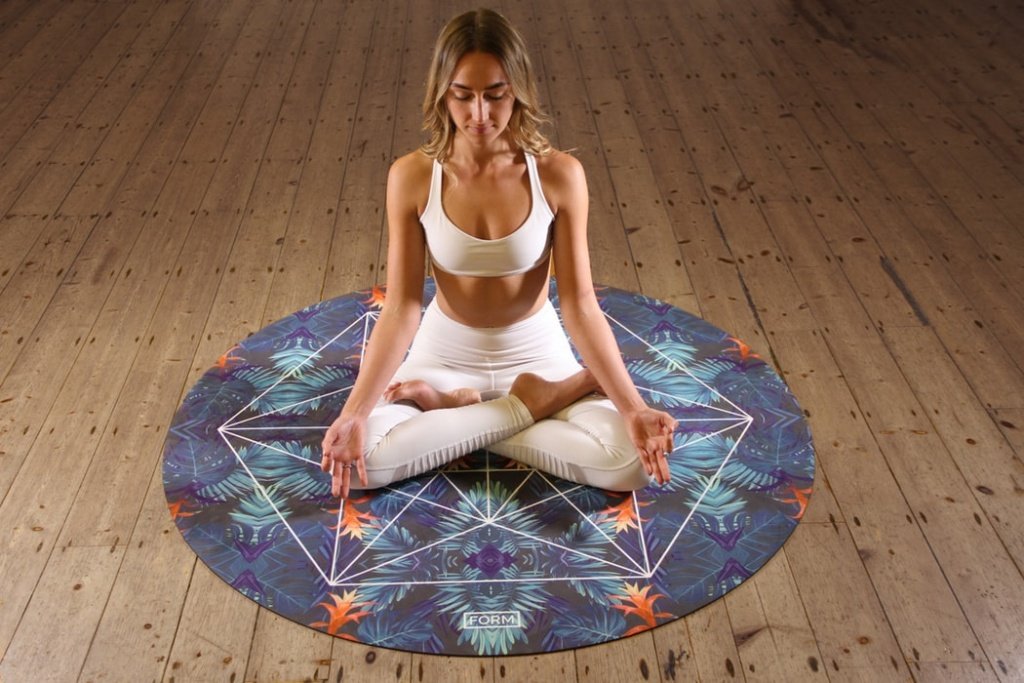
It increases your attention and ability to focus. Naturally, your balance will benefit from a regular Acro Yoga practice, and we all know that physical balance translates into mental balance in your daily life.
Once you become confident with one form, it challenges you to discover new ones. Talking about trust… that is the foundation of Acro Yoga!
Regular practice will no doubt help you develop trust towards other people, favoring better human relationships.

Starting from improved flexibility to stronger core and muscles and better resistance to fatigue.
As it normally is a bit more intense than a standard yoga class, your cardiovascular system will benefit from it.
Your joints will get stronger and more flexible at the same time.
Practice it outdoors and you will get all the health benefits of sports in the open air.
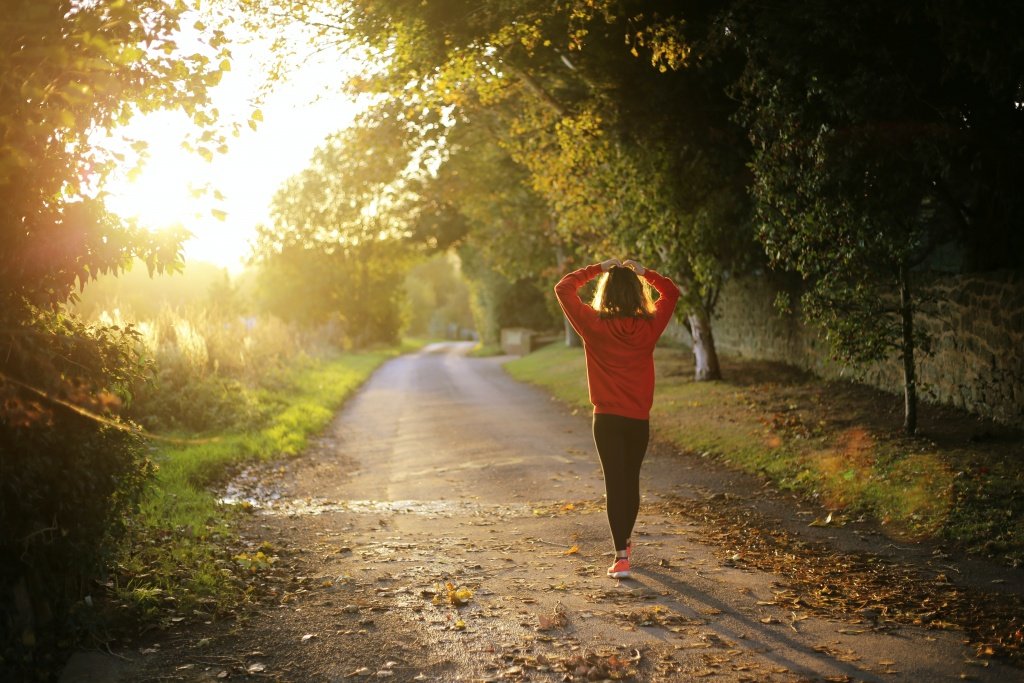
When practiced in a specific way, Acro Yoga can have therapeutic effects, combining massage techniques, inversions and regression.
Also known as Therapeutic Flying, this branch of Acro Yoga delivers to the flyer deep body awareness and mind relaxation, stretches the spine, and loosens up tensions.
Also the base benefits from it: it helps develop a strong sense of responsibility and care towards others. Giving is caring.
A basic therapeutic pose is Folded Leaf in which one partner is inverted and supported on the vertical legs of the other partner whose hands are then free for back massage.
By the way, this is not Aerial Yoga, a different branch of Yoga that involves the use of a hammock.
How to start learning Acro Yoga
Some people who have a background in Yoga or Acrobatics start practicing on their own, experimenting with balance and forms.
A self-discovery process and learning-by-doing is a positive approach to this technique, however, we recommend studying this type of yoga with an experienced teacher who will guide you through all the learning steps required by this technique, minimizing the risks of injuries.

Because of the increasing popularity of this technique, nowadays there are many centers, yoga schools and Acro Yoga communities offering courses and workshops.
Samma Karuna also integrated Acro Yoga classes into its monthly Awakening and Healing Program.
Once you learned the basics you can attend regular Acro Yoga events, called jams, where enthusiasts and expert practitioners come together to train, experiment and share, normally for free, this social branch of Yoga.
A search on Google or Facebook will bring up local groups. If you live in Thailand, you will definitely find several in Koh Phangan, Bangkok, Chiang Mai and Chiang Rai organizing classes and even retreats.
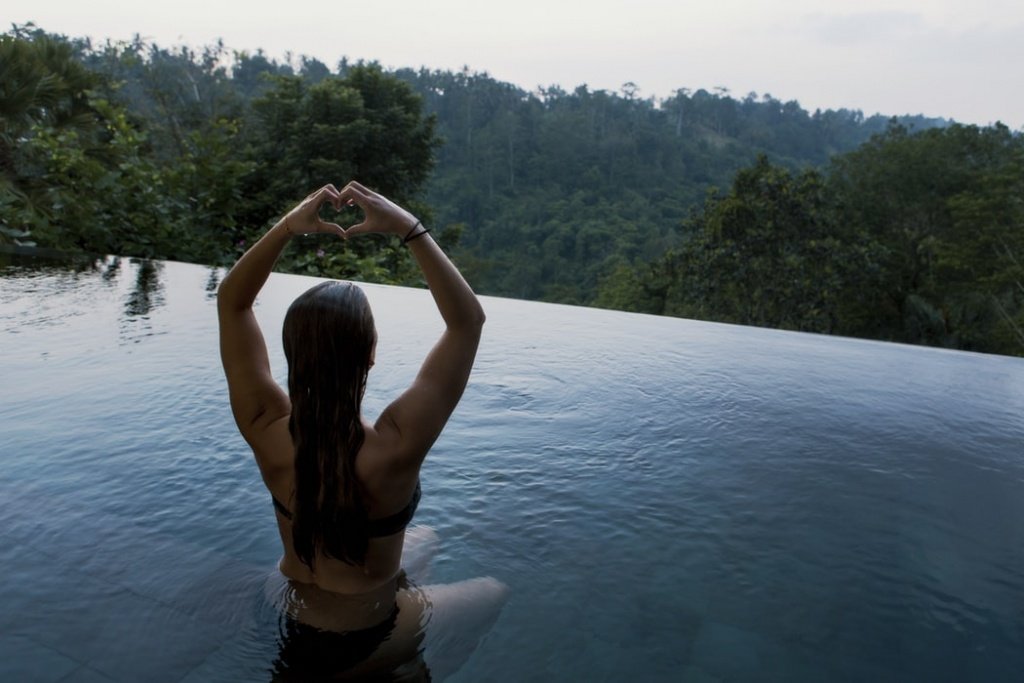
Learning it requires strength, flexibility and technique, for which you have to prepare specifically.
Train your strength, in particular arms and core, through push-ups, ab work, or even a good power yoga class.
Train your flexibility with a daily yoga practice and even better, partner yoga, which helps you stretch deeper while connecting with your partner.
As far as technique, you should refer to an expert. One of the most important features you will learn is bone stacking, which helps the base discharge the weight of the flyer on the ground through its bones.

Some tips for beginners
- Find an Acro Yoga group (or at least a partner, since this yoga is for two!). A community will motivate you, help you keep up your physical practice and share the group knowledge. Besides, it’s more fun!
- Build a trust relationship with your partner, get to know each other, and open up, there’s no lying when practicing.
- Start from the beginning, even if you are a yogi or an acrobat, be humble and go step by step.
- It is a good practice to start the session with a sharing circle (if you are in a group), which promotes openness.
- Start with a gentle full-body warm-up: simply explore all muscles and joints of your body and perform some easy stretching and of each part (elongate, rotate, move freely).
- Switch to a more dynamic warm-up, a few sun salutations or any other asana flow of your preference, and some partner yoga.
- Get started with your partner: from a standing position, the flyer leans on the base placing the feet on the groin or using a handgrip. The base receives the weight of the flyer who leaves the balance point leaning forward, trusting completely their base, who will support the flyer. The base will gently push the flyer away back to a standing position. Repeat this many times to find a good contact spot and get familiar with each other.
- Begin with some basic poses (see our list below) and progress to more advanced ones only when both of you feel confident.
- Pay attention to your balance, notice that sweet spot that keeps you in balance effortlessly. At the beginning it will be just a few seconds, then it will increase.
- Pace yourself and take breaks.
- Switching roles might help you understand positions and movements from both perspectives.
- Have a spotter available for extra safety and to get some suggestions from the outside.
- Be patient and kind to yourself, it takes time to get a good balance, connection with your partner and a solid technique

The most popular acro yoga positions
Let’s have a look at some basic Acro Yoga poses for two (the poses’ names can slightly change depending on the school).
Front Plank

This is the foundation for more advanced poses and probably the first one you will learn. The flyer adjusts the base’s feet position on their groin and leans forward lifting the legs up and grabbing the hands of the base.
It requires some core strength to lift the legs up and trust when leaning forward. The base bends its legs initially, then pushes up the flyer in a controlled way.
The flyer keeps both legs and arms straight perpendicular to the floor, the base has both legs and arms perpendicular.
Both arms are stacked. The base regulates the position of the flyer flexing or pointing the feet. The flyer bends the legs to come back and reach the floor.
Front Bird

Just like the Front Plank, with hands off! Once both of you feel confident, the flyer lets go of the base’s hands and spreads the arms backward.
The base can keep their arms up for extra safety (to grab the flyer just in case).
Bow

From Front Bird, the flyer reaches their hands back to grab the feet while lifting the chest up.
The base points their feet to help the flyer lift the chest. The flyer breathes slowly and deeply.
Whale
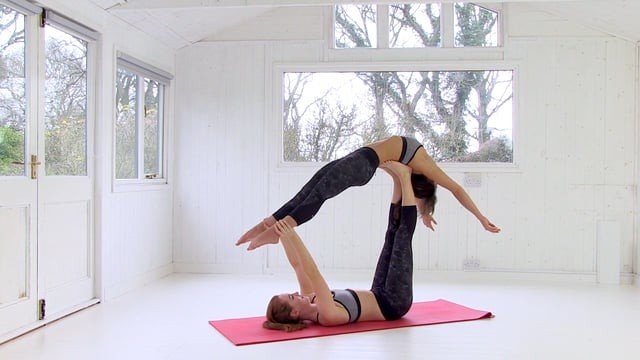
The flyer places their feet at both sides of the base’s neck, facing the opposite direction of the base.
The base grabs the ankles of the flyer and places its feet on the flyer’s upper back.
The flyer engages the core while leaning backward. The base initially bends their legs, then pushes up the flyer’s back while supporting their ankles on the way up.
The flyer can stretch their arms above the head. When the flyer wants to come out, the base pushes the upper back of the flyer to a standing position while guiding the feet to the ground.
Folded Leaf

This pose is the base for therapeutic Acro Yoga (the base can massage the back of the flyer).
The base places their feet on the groin of the flyer as usual but turns them slightly out (this will give the flyer more space for the next movement).
From Front Plank the flyer lets go of the base’s hands and bends forward towards the base’s legs, keeping the legs straight
To come out, connect the hands as in Front Plank and the base slowly guides the flyer back to the ground (allowing enough time for the flyer to recover from a long inversion).
Conclusions
This was it! Hope you find this acro yoga for beginners tutorial helpful.
Acro Yoga is a very fun physical practice, a way to socialize with friends and open up, and become stronger and more flexible.
It has many benefits for your body awareness, your mind, your relationships and can even be therapeutic. It is easy to learn and experiment with new acro yoga poses. It’s great to practice at the beach or at the park with some friends.
It promotes balance, both physical and mental and it favors awareness and communication.
We highly recommend this practice and we invite you to join our classes at Samma Karuna or the next available workshop.


